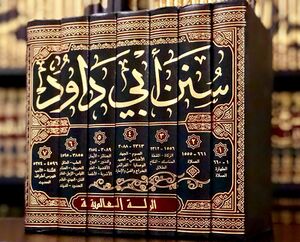Religion:Sunan Abu Dawood
 An all-collection of the Soonan Aboo Dawood | |
| Author | Abu Dawood |
|---|---|
| Original title | سنن أبي داود |
| Language | Arabic |
| Series | Kutub al-Sittah |
| Genre | Hadith collection |
Sunan Abu Dawood (Template:Lang-ar-at) is one of the Kutub al-Sittah (six major hadith collections), collected by Abu Dawud al-Sijistani (died 889).[1]
Introduction
Abu Dawood compiled twenty-one books related to Hadith and preferred those Ahadith (plural of "Hadith") which were supported by the example of the companions of Muhammad. As for the contradictory Ahadith, he states under the heading of 'Meat acquired by hunting for a pilgrim': "if there are two contradictory reports from the Prophet (SAW), an investigation should be made to establish what his companions have adopted". He wrote in his letter to the people of Mecca: "I have disclosed wherever there was too much weakness in regard to any tradition in my collection. But if I happen to leave a Hadith without any comment, it should be considered as sound, albeit some of them are more authentic than others". The Mursal Hadith (a tradition in which a companion is omitted and a successor narrates directly from Muhammad) has also been a matter of discussion among the traditionists. Abu Dawood states in his letter to the people of Mecca: "If a Musnad Hadith (uninterrupted tradition) is not contrary to a Mursal [Hadith], or a Musnad Hadith is not found, then the Mursal Hadith will be accepted though it would not be considered as strong as a Muttasil Hadith (uninterrupted chain)".
The traditions in Sunan Abu Dawood are divided in three categories. The first category consists of those of the traditions that are mentioned by Bukhari and/or Muslim. The second type of traditions are those which fulfil the conditions of Bukhari or Muslim. At this juncture, it should be remembered that Bukhari said, "I only included in my book Sahih Bukhari authentic traditions, and left out many more authentic ones than these to avoid unnecessary length".
Description
Abu Dawood collected 500,000 hadith, but included only 4,800 in this collection.[2] Sunnis regard this collection as fourth in strength of their six major hadith collections. It took Abu Dawod 20 years to collect the hadiths. He made a series of journeys to meet most of the foremost traditionists of his time and acquired from them the most reliable hadiths, quoting sources through which it reached him. Since the author collected hadiths which no one had ever assembled together, his sunan has been accepted as a standard work by scholars from many parts of the Islamic world,[3] especially after Ibn al-Qaisarani's inclusion of it in the formal canonization of the six major collections.[4][5][6]
Abu Dawood started traveling and collecting ahadeeth at a young age. He traveled to many places in the middle east, including Egypt, Iraq, and Syria. Abu Dawood also studied under Imam Ahmad Ibn Hanbal.[7]
Contents
Editor, Muhammad Muhyiddin Abd al-Hamid's 1935, Cairo publication, in 4 volumes, provides the standard topical classification of the hadith Arabic text.[8] Sunan Abu Dawood is divided into 43 'books'.[9][10][11]
Commentaries and translations
Sunan Abu Dawood has been translated into numerous languages. The Australian Islamic Library has collected 11 commentaries on this book in Arabic, Urdu and Indonesian.[12] One of the best commentaries for Sunan Abu Dawood had been written by Khalil Ahmad Saharanpuri entitled Badhl Al-Majhud Fi Hall Abi Dawud, an 18-volume commentary on the hadith.
See also
- Sahih al-Bukhari
- Sahih Muslim
- Sahih al-Tirmidhi
- Sunan al-Nasa'i
- Either: Sunan ibn Majah, Muwatta Imam Malik
References
- ↑ Jonathan A.C. Brown (2007), The Canonization of al-Bukhārī and Muslim: The Formation and Function of the Sunnī Ḥadīth Canon, p.10. Brill Publishers. ISBN:978-9004158399. Quote: "We can discern three strata of the Sunni hadith canon. The perennial core has been the Sahihayn. Beyond these two foundational classics, some fourth/tenth-century scholars refer to a four-book selection that adds the two Sunans of Abu Dawood (d. 275/889) and al-Nasa'i (d. 303/915). The Five Book canon, which is first noted in the sixth/twelfth century, incorporates the Jami' of al-Tirmidhi (d. 279/892). Finally the Six Book canon, which hails from the same period, adds either the Sunan of Ibn Majah (d. 273/887), the Sunan of al-Daraqutni (d. 385/995) or the Muwatta' of Malik b. Anas (d. 179/796). Later hadith compendia often included other collections as well.' None of these books, however, has enjoyed the esteem of al-Bukhari's and Muslim's works."
- ↑ Mohammad Hashim Kamali (2005). A Textbook of Hadith Studies: Authenticity, Compilation, Classification and Criticism of Hadith, p. 39. The Islamic Foundation
- ↑ "Various Issues About Hadiths". http://www.abc.se/~m9783/n/vih_e.html.
- ↑ Ignác Goldziher, Muslim Studies, vol. 2, pg. 240. Halle, 1889-1890. ISBN:0-202-30778-6
- ↑ Scott C. Lucas, Constructive Critics, Ḥadīth Literature, and the Articulation of Sunnī Islam, pg. 106. Leiden: Brill Publishers, 2004.
- ↑ Ibn Khallikan's Biographical Dictionary, translated by William McGuckin de Slane. Paris: Oriental Translation Fund of Great Britain and Ireland. Sold by Institut de France and Royal Library of Belgium. Vol. 3, pg. 5.
- ↑ "About - Sunan Abi Dawud - Sunnah.com - Sayings and Teachings of Prophet Muhammad (صلى الله عليه و سلم)". https://sunnah.com/abudawud/about.
- ↑ Hadith and the Quran, Encyclopedia of the Quran, Brill
- ↑ "Abu Dawud". http://hadithcollection.com/abudawud.html.
- ↑ "Sunan Abi Dawud". https://sunnah.com/abudawud.
- ↑ "All books and chapters of sunan abu dawood". https://www.islamicfinder.org/hadith/abu-dawud/.
- ↑ "Sunan Abu Dawood". http://www.australianislamiclibrary.org/sunan-abu-dawood.html.
External links
- Sunan Abu Dawud online at Sunnah.com
- Translation and Commentaries in English, Urdu, Arabic and Indonesian Languages
- English translation of Sunan Abu Dawud
 |

